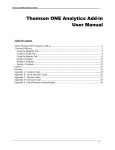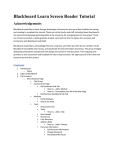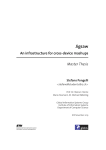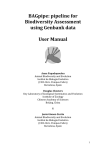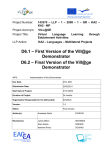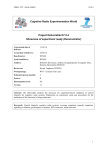Download Senior Projects for F2013 – S2014 (Round 1)
Transcript
EUROPEAN UNIVESITY CYPRUS | Department of Computer Science and Engineering Senior Projects for F2013 – S2014 (Round 1) Potential CSC/ECE490 students, please note the following - 4 steps to start: Find a project; See the supervisor and take the project; Sign the contract; Get registered for 490 You cannot register before you sign the contract You cannot sign the contract unless you have senior standing (96+ credits) and GPA > 2.00 1 You cannot take a project over the phone or email This list (and relative updates to it) will be posted on http://faculty.euc.ac.cy/agrondoudis/index.htm Any courses mentioned as required in a project must be passed with a grade C or greater2 Supervisor Efstathiou Gregoriades Grondoudis Dimopoulos Number 1 2 3 4 5 6 7 8 9 Christou Hadjiloucas Stylianou Katzis Papanikolaou Nikiforou Mavromoustakos Papadopoulou 1 2 10 11 12 13 14 15 16 17 18 19 20 21 22 23 24 25 26 Project title (if the title is missing then the project has been allocated) Development of photometric redshift code Development of an online version of fastPheonix Develop a driving simulator using a 3D game engine An embedded system to provide basic fleet management functionalities Apartment Building Management Systems (ABMS) Visual Scheduler Research Center Website and CMS Developing an evolutionary computation scheduling algorithm for a real-life industrial environment Using Logisim as the basic for teaching digital logic and computer architecture concepts The gaming habits of Cypriot students An Android video game that allows content updates Tracing continuous sufficiently smooth curves in an image Detecting the shortest path connecting two points Development of a tourist information mobile application Adaptive location aware services iGreenHouse, an electronically controller greenhouse. Tree Mapping using digital image processing in Matlab Automated Road Traffic Embedded Management Intelligent System (ARTEMIS) Creating a distance learning platform for primary school mathematics Network simulator using NS3 Hands on linear programming: a step-by-step solution Testing for prime numbers Development of an online faculty scheduling system A research “Mashup” system Developing of a tool in C for modeling astronomical data (co-Efstathiou) Investigating Nash equilibria in Facility location games (co-Stylianou) If your GPA is close to 2.00, talk the matter over with the potential supervisor If you have passed the course with D or D+ discuss the issue with the supervisor of the project 1 Supervisor Andreas Efstathiou Project title Development of a photometric redshift code Project status: Available Brief Quite often in astronomy it is not possible to take a spectrum of an object and measure its description redshift and therefore its distance, luminosity etc.. In cases where photometry in a number of bands is available it is possible to determine a so-called photometric redshift. The aim of this project is to develop a web tool that will carry out this task. Objectives (including grade worth and optionally deadlines) Pre-requisite Course(s) Recommended Course(s) Other comments Objective name & description Learn a Web programming API: The first objective of the project is to learn and/or use a web programming API which will be used for developing the web tool Worth (%) 15% Deadline 01/11 Develop capability for entering data: The next objective is to develop the capability for entering the data. The data will consist of three real numbers for each data point (wavelength or frequency, flux and its associated error). The tool should allow the flexibility of either entering the data interactively or reading them from a text file. In either case the user should be informed and given an example of the form in which the data should be entered. 15% 01/12 Develop the capability to select templates: To determine the redshift of the source, the tool will compare the photometric data with spectra of different classes of galaxies in which the redshift is known (templates). The tool should therefore provide the flexibility to select the templates to be used and should also allow the user to import his or her own templates. 20% 01/01 Carry out calculations: The next objective is to carry out the calculations for estimating the photometric redshift. To do this the tool should shift the wavelength of the templates in small steps of redshift from say 0 to 10. For each shift and for each template the tool should compare the real data with the template and calculate the 2 χ statistic. 15% 01/02 Display the best solution: Finally the tool should display the best 2 solution on a plot and give the minimum χ . 15% 01/03 Write dissertation: The student should write up a technical report (dissertation) and present it. 20% 01/04 The project requires good web programming skills CSC209, MAT217, CSC134, CSC135 Attendance of the course CSC450 or ECE450 (Data Analysis and Data Mining) which is offered in Fall 2013 is recommended 2 Supervisor Andreas Efstathiou Project title Development of an online version of fastPhoenix Project status: Available Brief fastPhoenix is a code that calculates the emission of a galaxy over most of its spectrum description given its star formation history and certain other parameters. The code has been developed by the supervisor in the Interactive Data Language (IDL) environment. The aim of this project is to develop an online version of this code. Objectives (including grade worth and optionally deadlines) Pre-requisite Course(s) Recommended Course(s) Other comments Objective name & description Worth (%) Deadline Learn a Web programming API: The first objective of the project is to learn and/or use a web programming API which will be used for developing the web tool. 15% 01/11 Develop capability for entering the parameters: The next objective is to develop the capability for entering the parameters of the model that will be used in the calculation. 15% 01/12 Read necessary data and calculate spectrum of a galaxy: The next objective is to read all necessary data and carry out the calculation of the spectrum of the galaxy. 35% 01/02 Plot spectrum and make it available: Finally the tool should display the spectrum on a plot and make the spectrum available to the user for download. 15% 01/03 Write up dissertation: The student should finally write up a technical report (dissertation) and present it. 20% 01/04 The project requires good web programming skills CSC209, CSC134, CSC135 Attendance of the course CSC450 or ECE450 (Data Analysis and Data Mining) which is offered in Fall 2013 is recommended 3 Supervisor: Project title: Brief description: Andreas Gregoriades Develop a Driving simulator using a 3D game engine Driving simulators are being increasingly used worldwide for evaluating driving behavior among other uses. Research has shown that driving simulators are proven to be excellent practical and effective tools to analyse road safety issues. This project aims in enhancing a developed driving simulator implemented using a 3D game engine (UNITY). The simulator mimics a road section of the Cyprus roadway network for which the accident statistics are high (black spot). The simulator will be used to evaluate different in-vehicle driver assistive technologies (IVAT) using Cypriot road users in different scenarios. The IVATs specification will focus on different ways to augment drivers’ situation awareness (driver’s ability to realize what is happening around him/her and forecast this into the future). The project aims in the design and implementation, in UNITY, of a number of prototype versions of future IVAT. These IVAT will mimic future designs to be used in vehicles and in this way help vehicle manufacturers validate the effectiveness of these systems prior to their implementation. The implemented virtual IVAT will be evaluated with users in an experiment. Project objectives: Required knowledge / Pre-requisite course(s) 1. Identify specification of 10% future IVAT that aim to enhance situation awareness of driver. 2. Design and develop 40% selected IVAT in UNITY. 30% 3. Conduct a series of experiments with users to examine the effectiveness of the virtual in-vehicle driver assistive technologies in realistic conditions. Analyze the collected data. 4. Dissertation report 10% 10% 5. Presentation Good programming skills (CSC326) and knowledge of game design (CSC391), Willingness to learn 3D game design. Dedication and enthusiasm in learning new technologies are necessary characteristics you need to possess. The student should be able to work hard in order to meet rigid project deadlines as these will be discussed and agreed between the supervisor and the student. Failure to meet these deadlines will result in discontinuation of the project (which will result in an automatic ‘F’ grade) 4 Supervisor: Project title: Brief description: Andreas Gregoriades An embedded system to provide basic fleet management functionalities Fleet management is the management of a company's transportation fleet. Fleet management includes commercial motor vehicles such as cars, ships, vans and trucks. Fleet (vehicle) management can include a range of functions, such as vehicle maintenance, vehicle telematics (tracking and diagnostics), driver management, speed management, fuel management and health and safety management. Fleet Management is a function which allows companies which rely on transportation business to remove or minimize the risks associated with vehicle investment, improving efficiency, productivity and reducing their overall transportation and staff costs. This project aims to program a prototype embedded system component that provides basic fleet management functions by collecting data through the use of in-vehicle sensors. The aim of the project is to monitor the location, acceleration and deceleration patterns of a bus operated by OSEL in Nicosia, and communicate these to a central server. The sensors that will be used for monitoring are already available on the bus. To undertake the project the student will be provided with a prototype monitoring component developed by DELPHI (http://delphi.com/). The monitoring component is equipped with 3G and GPS antennas and operates a Linux micro operating system. The component will be placed on a Nicosia buss, operated by OSEL. The component will communicate its position and other observed conditions from its sensors, to a central server in real time. The infrastructure for this project will be provided and the focus will be on the programming (C programming language) of the DELPHI embedded system to communicate with the server and the development of a visualization algorithm to project the bus’s location. Project objectives: Required knowledge / Pre-requisite course(s) 1. Learn how to manipulate the DELPHI component 2. Develop the algorithm to collect data from sensors connected to the DELPHI component. The algorithm will be in C and will be running on the component. 3. Develop the algorithm that will communicate the location and sensor’s state to a web server. The algorithm will be running on the DELPHI component. 4. Develop a simple web interface to display the monitored data in real time. 5. Dissertation report 6. Presentation 10% 35% 35% 10% 10% Very good programming skills especially in C (CSC326) - Good web development skills (CSC209) - Willingness to learn about embedded systems. Dedication and enthusiasm in learning new technologies are necessary characteristics you need to possess. The student should be able to work hard in order to meet rigid project deadlines as these will be discussed and agreed between the supervisor and the student. Failure to meet these deadlines will result in discontinuation of the project (which will result in an automatic ‘F’ grade) 5 Supervisor Project title Andreas Grondoudis Apartment Building Management System (ABMS) Project status: Available Brief Create a database management system to manipulate the data for a company that description manages multiple apartment buildings. You are to design the database to accommodate the data and create a front application end to enable the easy, quick and efficient manipulation of the data by the user. The system will enable the manipulation of multiple apartment buildings. Each building will have basic demographics and multiple apartments. For each apartment, apart from the demographics, the system will also hold and manipulate details pertaining to the common expenses of the building operation (electricity, sewage, cleaning, maintenance and other) Objectives (including grade Objective name & description Worth (%) Deadline worth and The student must perform an investigation of how are 10 20-Oct optionally common expenses estimated in Cyprus apartment deadlines) buildings. The findings will be entered in a report that will form the background chapter of the final thesis and formulate a guide for the further development of the database and the software in general Based on the initial investigation, the student must design a relational database that will hold and enable the programmatic manipulation of information. 20 20-Nov Based on the database design, the student must design and implement a front-end application which will be linked to the database and will allow for the easy, quick, efficient, correct (and possible customisable) manipulation of the database entries. 40 20-Feb The student must design and implement a reporting module for the system. The module will include fixed reports for outputting listings and/or other receipt-like documents. The module must also include ability to filter data according to certain criteria inputted by the user. 10 20-Mar Pre-requisite CSC231, CSC331, CSC411 Course(s) Recommended CSC135 Course(s) Other The interesting aspect of this project will be the ability of the software to enable the user to comments customise certain calculations (for shared bills) according to user needs and what exactly happens on their specific apartment building. 6 Supervisor Project title Project status: Brief description Objectives (including grade worth and optionally deadlines) Andreas Grondoudis Visual Scheduler Available Create an application that will allow the visual scheduling of courses for the department of computer science and engineering. The system will have a database to store information relating to courses, instructors, constraints etc. The application will use import and export capabilities to read in and/or output scheduling requirements. The application will also use drag-and-drop functionality to manipulate the courses and their physical arrangement in the weekly schedule. Objective name & description Worth (%) 10 Deadline Based on the initial investigation, the student must design a relational database that will hold and enable the programmatic manipulation of information. 20 20-Nov Based on the database design, the student must design and implement a front-end application which will be linked to the database and will enable the drag-and-drop scheduling of courses based on a set of predefined constraints 40 15-Mar The student will initially perform an investigation of the state of the art in visual scheduling. Also time will be spent in obtaining exact requirements for the system so as to provide ease of use; effectiveness and automation for the process 30 Oct The student must design and implement an importing / exporting 10 30-Mar module for the application. The development of this will go in parallel with the tool as the import functionality will be needed at the beginning. Pre-requisite CSC231, CSC331, CSC411 Course(s) Recommended CSC135 Course(s) Other The interesting aspect of this project will be to manipulate scheduling constraints comments programmatically and enable the visual manipulation of courses according to user input as well as constraint referencing. 7 Supervisor Project title Andreas Grondoudis & Christos Kassimeris Research Center Website (and CMS) Project status: Available Brief The department of Social and Behavioural Sciences headed by Dr Kassimeris will be description establishing the Euro-Mediterranean Research Center (EMRC). In an effort to further promote the center and its activities Dr Kassimeris (hereinafter referred to as the client) is looking to create a website and a CMS to manage the site. This project will create a website and provide means for the update and maintenance of the site even after the project has finished. We will be looking for a (will-be) skilled web developer that will create or utilise a content management system. The system will be in place for future updates by non-technical personnel. Objectives (including grade worth and optionally deadlines) Objective name & description Worth (%) 10 Deadline Based on the initial investigation the student will: - Learn to use software to deliver a CMS (to be used for the website) - Design a database that will be used as the basis for a manually created (by the student) CMS and website to the specific end of creating the website 20 20-Nov Design / build / program a CMS and a respective website according to client requirements. The work will provide complete coverage of client needs and wants and also cater for future maintenance update and possible expandability of the site. The work will deliver a user-based access system whereby registered users can login and update profile and/or website content 40 20-Feb The student must also design and provide - Backup and restore facilities - Import / export facilities (if applicable) - A detailed user-manual that can be used in the future to guide non-technical personnel through the process of maintaining the site. 10 30-Mar The student will initially perform and investigation of the state of the art in content management systems available for free. This will be documented and presented to the client along with a recommendation on what will be the best approach for the wanted site. This report will be used in the thesis as the background information 30 Oct Pre-requisite CSC209, CSC331, CSC411 Course(s) Recommended CSC135 Course(s) Other This will be a challenging and very interesting project as it will get you involved in the comments creation of a website either manually (programming with PHP, MySQL and Apache) or semiautomatically (Joomla or other tools). Needless to say that the skills obtained from this project along with the experience is invaluable for the industry. 8 Supervisor: Dr. Christos Dimopoulos Project title: Developing an evolutionary computation scheduling algorithm for a real-life industrial environment Aim: The aim of this project is to develop an evolutionary scheduling algorithm which will solve a real-life scheduling problem in a Cypriot manufacturing company. The operation of the solver will be integrated within an existing IT scheduling decision support system which has already been developed for the manufacturing environment in consideration Taught Theoretical Knowledge Covered Writing for Computer Science (CSC135) Programming Principles (CSC131 & CSC132) Data Structures (CSC205) Systems Analysis & Design (CSC230) Programming in Unix-like environments (CSC326) New Knowledge Gained Activities: Basic theoretical concepts of production scheduling Understanding & design of evolutionary computation algorithms 1. Review of evolutionary computation algorithms Deadline: 1st of December 2013 Deliverable 1: Evolutionary computation review 2. Development of evolutionary computation algorithm for the solution of the real-life scheduling problem Deadline: 1st of January 2014 Deliverable 2: Evolutionary computation solver 3. Testing & Results Deadline: 1st of February 2014 Deliverable 3: Results of algorithm’s testing 4. Integration of solver with existing support system Deadline: 1st of March 2014 Deliverable 4: IT support system with solver capability 5. Development of a technical report (dissertation) which will describe all activities undertaken Deadline: 30th of April 2014 Deliverable 5: Project’s dissertation Draft Dissertation Structure & Grading 1. Introduction Grade Percentage: 10% 2. Evolutionary Computation Concepts Grade Percentage: 10% 3. Design of an evolutionary computation algorithm for the design of a real-life scheduling problem Grade Percentage: 30% 4. Implementation, testing % results Grade Percentage: 30% 5. Conclusions Grade Percentage: 10% (10% of the final grade is allocated for the quality of the final presentation) Registration Requirements Interested students must have successfully passed all courses related to the taught theoretical knowledge covered, as these were described earlier. The absolute (non-negotiable) case-specific deadlines which are indicated in the objectives section apply for this project. I reserve the right to withdraw (before the 15th of January 2014) or fail (after the 15th of January 2014) the student from this course in case any of these deadlines are not met due to student’s liability. As with any departmental courses, a student can refer the case to the Departmental Grievance Committee if she/he feels that she/he has been unfairly treated. A weekly meeting will take place between the supervisor of the project, at a time and place jointly decided. . I reserve the right to withdraw (before the 15th of January 2014) or fail (after the 15th of January 2014) the student from this course in case she/he misses two consecutive project meetings without previous notice for official reasons. 9 – Only by Computer Engineering students Supervisor: Dr. Christos Dimopoulos Project title: Using Logisim as the basis for teaching digital logic and computer architecture concepts Aim: The aim of this project is to provide an electronic Teaching Support system which will help students understand digital logic and computer architecture concepts through the use of the Logisim educational software. Taught Theoretical Knowledge Covered Writing for Computer Science (CSC135) Digital Logic (CSC213) Digital Circuit Design (ECE273) Computer Organisation and Architecture (CSC214) New Knowledge Gained Activities: Review of digital logic educational tools Mastering of the Logisim educational software 1. Review of the Logisim software and its functionality Deadline: 1st of November 2013 Deliverable 2: Logisim Review 2. Review of existing digital logic and computer architecture educational tools Deadline: 1st of February 2014 Deliverable 1: Digital Logic Educational Tools 3. Digital Logic course design and implementation of exercises Deadline: 1st of January 2014 Deliverable 3: Digital Logic Course Design Deliverable 4: Digital Logic Exercises 4. Computer Architecture course design and implementation of exercises Deadline: 1st of March 2014 Deliverable 3: Computer Architecture Course Design Deliverable 4: Computer Architecture Exercises 5. Development of a technical report (dissertation) which will describe all activities undertaken Deadline: 30th of April 2014 Deliverable 6: Project’s dissertation Draft Dissertation Structure & Grading 1. Introduction Grade Percentage: 5% 2. Digital Logic & Computer Architecture Educational Tools Grade Percentage: 10% 3. Logisim Software User Manual Grade Percentage: 10% 4. Using Logisim for teaching digital logic concepts Grade Percentage: 30% 5. Using Logisim for teaching computer architecture concepts Grade Percentage: 30% 6. Conclusions Grade Percentage: 5% (10% of the final grade is allocated for the quality of the final presentation) Registration Requirements This project can only be undertaken by Computer Engineering students (ECE490). Interested students must have successfully passed all course and laboratories related to digital logic and computer organization and architecture. The absolute (non-negotiable) case-specific deadlines which are indicated in the objectives section apply for this project. I reserve the right to withdraw (before the 15th of January 2014) or fail (after the 15th of January 2014) the student from this course in case any of these deadlines are not met due to student’s liability. As with any departmental courses, a student can refer the case to the Departmental Grievance Committee if she/he feels that she/he has been unfairly treated. A weekly meeting will take place between the supervisor of the project, at a time and place jointly decided. . I reserve the right to withdraw (before the 15th of January 2014) or fail (after the 15th of January 2014) the student from this course in case she/he misses two consecutive project meetings without previous notice for official reasons. 10 Supervisor Dr. Georgios Christou Project title The gaming habits of Cypriot Students Project status: Available Brief The student will have to compose a questionnaire and disseminate it to schools all over description Cyprus to gauge the gaming habits of Cypriot students Objectives (including grade worth and optionally deadlines) Objective name & description Worth (%) Questionnaire creation 10 Questionnaire dissemination 20 Questionnaire results tabulation 20 Questionnaire results analysis 30 Final Report 15 Presentation 5 Deadline Pre-requisite Course(s) Recommended CSC134, CSC135, MAT217 Course(s) Other The student will learn how to conduct a large scale investigation, learn how to gather and comments analyse data using specific Statistics software, and will also learn how to conduct statistical analyses using said software. 11 Supervisor Dr. Georgios Christou Project title An Android video game that allows content updates Project status: Available Brief The student will have to take a video game that was created in the CSC 391 course in Flash, description and produce the following changes: 1. Allow additions of new storylines 2. Allow additions of new puzzles 3. Create additional content for the game 4. Create an online repository from where the game will receive the updated content Objectives (including grade Objective name & description Worth Deadline worth and (%) optionally Allow addition of new storylines 20 20 deadlines) Allow additions of new puzzles Create additional content for the game 20 Create an online repository 20 Final report 15 Presentation 5 Pre-requisite Course(s) Recommended Course(s) Other comments CSC 391 CSC 133 The student will learn the whole process of game development in Flash, and learn how to create an online repository from where flash files can be downloaded and input into an application without changing the application. 12 Project supervisor(s) Project title Brief project description: Project objectives Pre-requisite courses: Required knowledge: Demetris Hadjiloucas Tracing continuous sufficiently smooth curves in an image This project, as the title suggests, deals with tracing continuous sufficiently smooth curves that appear in an image. Each curve may self-intersect a number of times. The aim is to develop an algorithm for tracing the curves as they were drawn using a smooth continuous movement of the hand, meaning, to produce an ordered list of sufficiently many points on each curve which, if traced in the ordered given, will trace the curve from one end to the other. A program will be developed in Java (or another high-level language agreed upon with the project supervisor) which will: • Read in an image file containing continuous “sufficiently smooth” curves which may self-intersect a number of times (5%). • Identify the beginning and ending points on each curve (15%). • Identify a sufficiently large number of a sequence of points (spaced sufficiently close together on each curve) which, if traced in the order given, will trace out each curve (40%). A detailed analysis of the limitations of the algorithm as well as the software developed will be essential in this project (20%). Suggestions and ways to overcome obstacles will count favorably. It is expected that the results will be written up in the form of a Dissertation where analysis of all of the above steps is given (10%). The grading of the project will take into account various parameters such as student effort, originality and clarity in presentation of material, correctness and initiative in carrying out further work/research on the subject as well as the level of success achieved in carrying out all tasks required. It is also expected that the student will give a presentation of the project on the senior project open day (10%). CSC120, MAT101, CSC407, CSC132. Discrete Structures, Calculus I, Algorithms and Java Programming. 13 Project supervisor(s) Project title Brief project description: Project objectives Pre-requisite courses: Required knowledge: Demetris Hadjiloucas Detecting the shortest path connecting two points This project deals with detecting paths which connect two points in a two dimensional network and selecting the shortest one. The “network” is made up of a family of line segments drawn in the plane which intersect at a number of nodes. The network is given in the form of an image and the program must detect all nodes in the network. It must then use an algorithm to find the shortest path via which the two points are connected. A program will be developed in Java (or another high-level language agreed upon with the project supervisor) which will: • Read in an image file containing the network (5%). • Identify all nodes on this network and give a way for the user to specify the points to be path connected (the development of a user-friendly GUI will be necessary) (15%). • Use an algorithm to determine whether the two points are path connected (10%) • If points are path connected, use Dijkstra’s algorithm to identify the shortest path which connects the two points (30%). A detailed analysis of the algorithm as well as the software developed will be essential in this project (20%). Suggestions and ways to overcome obstacles as well as a comparison of Dijkstra’s algorithm with the improved Dijkstra algorithm using min-priority queue will count favorably. It is expected that the results will be written up in the form of a Dissertation where analysis of all of the above steps is given (10%). The grading of the project will take into account various parameters such as student effort, originality and clarity in presentation of material, correctness and initiative in carrying out further work/research on the subject as well as the level of success achieved in carrying out all tasks required. It is also expected that the student will give a presentation of the project on the senior project open day (10%). CSC120, MAT101, CSC407, CSC132. Discrete Structures, Calculus I, Algorithms and Java Programming. 14 Supervisor Dr. Georgios Stylianou Project title Development of a tourist information mobile application Project status: Available Brief The mobile application must be able to inform a tourist visiting old Nicosia (at least) the description following: • Provide information about historical monuments. Image, history, visiting times, entrance fee, etc. • Show on map the location of these monuments. • Provide walking directions; allow the user to create an itinerary. • Inform on events taking place. Objectives (including grade Objective name & description Worth Deadline (%) worth and optionally Generate user requirements 5 Fall ‘13 deadlines) Generate UI design 10 Fall ‘13 Generate and populate web database (data will be provided on a 10 Fall ‘13 map) Generate the mobile phone database 5 Fall ‘13 Create web services for updating information on the phone 15 Jan ‘14 Provide information, show on map, walking directions 10 Feb ‘14 Inform on events taking place 10 Mar ‘14 Generation of itinerary 15 Mar ‘14 Thesis report 10 Mar ‘14 Presentation 10 May ‘14 Pre-requisite CSC392, CSC205, CSC331 Course(s) Recommended CSC209 Course(s) Other comments 15 Supervisor Dr. Georgios Stylianou Project title Adaptive Location Aware Services Project status: Available Brief The base scenario is: A user interested in cheap gasoline, gets an alert when is in the description proximity of a cheap gas station. A user interested in gadgets, gets an alert when is in the proximity of a gadget store that has offers or new products. This requires the generation of a user profile that will be used to send notifications (these may include advertisements) adapted to the user’s needs. Objectives (including grade Objective name & description Worth Deadline worth and (%) optionally Literature review 10 Fall ‘13 deadlines) Definition of a user profile 10 Fall ‘13 Generation of user requirements 5 Fall ‘13 Implementation of the user profile 20 Fall ‘13 Generation of a database with Points of Interest (POI) and offers 5 Fall ‘13 Matching offers/ads to user profile 20 Feb ‘14 Region based alerts 10 Feb ‘14 Thesis document 10 Mar ‘14 Presentation 10 May ‘14 Pre-requisite CSC392, CSC205, CSC331 Course(s) Recommended CSC407 Course(s) Other comments 16 Supervisor: Project 1 title: Brief description: Project objectives: Dr Konstantinos Katzis iGreenHouse – an electronically controlled greenhouse An electronically controlled greenhouse is required to be designed, implemented and built for a local farmer. The prototype green house must be modelled on a small scale. The green house must be equipped with an intelligent system that will control the health of the plants. This will be achieved with a number of sensors and actuators to enable automatic treatment of the plants. The farmer requires you to design and build the mechanism that does all these based on a number of parameters that will be further discussed during the requirement and analysis process of your project. Some of the main features of this mechanism are: 1. LCD screen that displays information about the plants currently situated in the greenhouse. 2. Button that allows the user to select the types of plants situated in the greenhouse. 3. Sensors: Air and Ground Temperature, Humidity sensors, water actuators and fertiliser actuators, a small fan for generating air etc. 4. A small scale greenhouse e.g. 1m2 • • • • Required knowledge / Pre-requisite course(s) • • Student will appreciate and learn the process of designing and implementing a device by using existing knowledge, researching and finding solutions to overcome and practical problems. Student will recall principles from Electronics and Programming and apply them in real life. (15%) Student will carry out the design, implementation and testing of a multifaceted project that involves both software and hardware (programming a micro processor). o Hardware Design (10%) o Hardware Implementation (15%) o Hardware Testing (5%) o Software Design (5%) o Software Implementation (15%) o Software Testing (5%) o System Testing (5%) Through this project, the student will be able to plan and organise the lifecycle of the project and distinguish any problems. (5%) Student will learn to present findings through a technical report and an oral presentation (20%). ECE416 CSC326 17 Supervisor: Project 2 title: Brief description: Dr Konstantinos Katzis Tree Mapping using Digital Image Processing in MatLab The department of forestry is looking for a way to digitize its forests using aerial images. You are required to write a program that will process these aerial images and produce a vector of position of the trees. Depending on the resolution of the photo and the angle that the image has been taken, your code must be able to distinguish their positions, identify the high density and low density regions. In addition, based on the colours of the trees, your code must be able to distinguish the health of the forest and define the level of flammability. Your data will be used to simulate fires on real case forests. (some related links: http://remotesensing.spiedigitallibrary.org/article.aspx?articleid=1352336 http://www.imageprocessingplace.com/DIPUM-2E/dipum2e_main_page.htm) Project objectives: • • • • • Required knowledge / Pre-requisite course(s) • • Student will look into Forests and look into the literature regarding their natural or artificial positioning. In addition he/she will look into the health status of the forests based on current research work available in GIS literature. (10%) Student will identify techniques of digital image processing and signal processing in general. Further more he/she will implement one or more of these in MATLAB (10%) Student will carry out the design, implementation and testing of a simulation tool that will be devised in a technical programming language (MATLAB and / or C). o Simulation Scenarios to be investigated (10%) o Design of Simulator (10%) o Implementation in MATLAB (25%) o Testing (5%) o Comparison of results (10%) Student will appreciate and learn the process of using background knowledge, researching and solving a complex theoretical problem. Student will learn to present findings through a technical report and an oral presentation (20%). CSC322 CSC134 18 Supervisor: Project 3 title: Brief description: Project objectives: Required knowledge / Pre-requisite course(s) Dr Konstantinos Katzis Automated Road Traffic Embedded Management Intelligent System (ARTEMIS) An automated road traffic embedded management intelligent system must be developed based on a low cost platform such as Arduino UNO ® to control the flow of traffic in real time based on a number of traffic models and input from a series of sensors. Previous work [1] has investigated the efficiency of traffic lights and introduced three phases. The algorithm developed emulates real-time information collected by a wireless sensor network to determine the sequence and length of traffic signals. The sequence of phases is determined using three priority levels. The first is the number of times that a phase did not get the green light indication. The second level is the waiting saturation degree and the third is the saturation degree. The algorithm calculates the length of each phase using dynamic programming. The algorithm tries to minimize the intersection delay by calculating the delay for each phase for all seconds available in the traffic cycle. Based on these findings, a new system must be developed that can be easily adapted by existing traffic lights in order to control the local traffic flow. The system must be equipped with a number of sensors that can detect incoming vehicles. It must also be able to detect their noise levels and their size / weight. Based on these findings and based on the 3 levels defined in [1] you must be able to demonstrate practically a complete road traffic management system on a small scale (using possibly radio controlled cars). • Student will look into implementing a complete Road Traffic Management system. The student will appreciate and learn the process of designing and implementing a device by using existing knowledge, researching and finding solutions to overcome and practical problems. Student will recall principles from Electronics and Programming and apply them in real life. (15%) • Student will carry out the design, implementation and testing of a multifaceted project that involves both software and hardware (programming a micro processor). • Hardware Design (10%) • Hardware Implementation (15%) • Hardware Testing (5%) • Software Design (5%) • Software Implementation (15%) • Software Testing (5%) • System Testing (5%) • Through this project, the student will be able to plan and organise the lifecycle of the project and distinguish any problems. (5%) • Student will learn to present findings through a technical report and an oral presentation (20%). • • CSC322, ECE416 CSC134 19 Supervisor Katerina Papanikolaou Project title Creating a distance learning platform for primary school maths Project status: Available Brief The project will require client and server-side scripting. Starting with the creation of web description pages testing the pupil’s knowledge of certain mathematical (3rd grade maths 8-9yrs old) concepts, available material at akida.org. These pages will have the form of quizzes (20 will be needed). The student will have to use xampp for recording the pupils’ answers and provide feedback to both student and teacher. The feedback given to the teacher will be per pupil and in total and there will be an extra tool providing feedback on pupil progress across time. Objectives (including grade Objective name & description Worth Deadline worth and (%) optionally Literature review: e-Learning Platforms 15% 16/10/13 deadlines) Literature review: Tools for Platform development 10% 30/10/13 10% 20/11/13 Review of 20 topics for 3rd grade maths Install XAMPP 5% 27/11/13 e-Learning Platform: Requirements analysis 10% 18/12/13 e-Learning Platform: Design 10% 29/01/14 e-Learning Platform: Implementation 10% 12/03/14 e-Learning Platform: Testing 10% 02/04/14 Thesis write-up 20% * Pre-requisite CSC209, CSC331, Course(s) Recommended Co-requisite CSC411 Course(s) Other *write-up will start from day one and will be completed according to department policy comments 20 Supervisor Katerina Papanikolaou Project title Network Simulation Using Ns3 Project status: Available Brief The project starts by introducing the student to the world of simulation, its function, use and description importance. The student will subsequently focus in the area of network simulation by downloading installing and building a network simulator. In the last stage the student will be required to write his own scripts, compile and verify their operation, and obtain results. Objectives (including grade Objective name & description Worth Deadline worth and (%) optionally Introduction to computer simulation 5% 16/10/13 10% 30/10/13 deadlines) Literature review of network simulators Literature review of TCP protocol and its versions 10% 20/11/13 NS-3 installation and building 5% 04/12/13 Traffic generation 10% 18/12/13 TCP simulation with script writing 20% 12/02/14 Obtain results 10% 26/02/14 Compare results 10% 19/03/14 Thesis write-up 20% * Pre-requisite CSC322, CSC326, CSC327 Course(s) Recommended ECE362 Course(s) Other *write-up will start from day one and will be completed according to department policy comments Programming: C++ / Python, Operating System: Unix based operating system 21 Supervisor Marina Appiou Nikiforou Project title Hands on Linear Programming – A step-by-step solution Project status: Available Brief This project purpose is to design a piece of educational software (program) for solving a description linear programming model with two variables with a step-by-step geometric approach. This involves graphing inequalities, solving a system of linear equations, determining the feasible set of such a set and determining its corner points, and finally determine the solution (if any) of a given linear programming problem. A linear programming problem is a combination of linear inequalities (called the constraints) and an objective function which you want to maximize or minimise (if possible). The program should be user friendly and with a nice colourful interface since is planned to be used for demonstrating the corresponding material to students who take BUS111 course. Objectives (including grade Objective name & description Worth Deadline (%) worth and optionally 1. Solve a system of linear equations of two variables 10 Oct20 deadlines) algebraically using matrices 2. Generalize step 1 for more variables 5 Oct30 3. Graph a linear equation and a linear inequality (two 10 Nov15 variables) – give slope and intercepts 4. Solve a system of linear equations graphically – show and 10 Nov30 give common point (if any) 5. Solve a system of linear inequalities and graph the 15 Jan10 solution – in your graph you will need to clearly show the feasible set 6. Locate the corner points of the solution in step 4 10 Jan30 7. Maximize/Minimize the given objective function for 10 Feb15 those corner points 8. Graph everything together – constraints and objective 10 Feb28 function – show the solution (if any) Pre-requisite CSC205, MAT206 Course(s) Recommended BUS111 Course(s) 1. Mandatory weekly meetings with the instructor or otherwise as agreed Other 2. The instructor maintains the right to assign an F grade at any time if the student fails comments to provide sufficient work. 22 Supervisor Marina Appiou Nikiforou Project title Testing for prime numbers Project status: Available Brief Given a positive integer your program should be able to determine whether this integer is description prime or composite, and if composite, determine its prime factorization. You should use a variety of tests - many primality tests are known; like the Sieve of Eratosthenes or other sieves, square root test, Fermat’s Little theorem and its’ extension using Euler φ function, Miller-Rabin test, AKS primality test and so on. All of the tests must appear on the same interface for the user to pick the ones to be used. You should also provide the history, theory, variations and applications of prime numbers especially in cryptography. Objectives (including grade Objective name & description Worth Deadline (%) worth and 1. Background reading and collecting information on the 15 Oct25 optionally history, theory of prime numbers and the primality tests deadlines) 2. For each primality test create a running program with 40 Dec20 output either the prime number or the number together with its divisors 3. You need to compare the complexity and running time of 10 Jan20 your algorithms 4. Discuss on different kind of primes; Mersenne primes, 10 Feb10 twin primes, Gaussian primes, happy primes etc. How do your algorithms behave with these primes? 5. Find applications of prime numbers in different areas 5 Feb28 Pre-requisite CSC205, Mathematically mature Course(s) Recommended MAT205 Course(s) 1. Mandatory weekly meetings with the instructor or otherwise as agreed Other 2. The instructor maintains the right to assign an F grade at any time if the student fails comments to provide sufficient work. 23 Supervisor: Project title: Brief description: Objectives (remember to include a 80% grading matching the objectives): Required knowledge (course(s)) Dr. Stephanos Mavromoustakos Development of an Online Faculty Scheduling System Currently the Department of Computer Science and Engineering performs scheduling for its faculty using Excel. As a result the process is too slow and mistakes happened quite often. The purpose of this project is to computerize this process using a programming language and a database system so it can provide fast, and accurate scheduling considering all peculiarities of scheduling and be accessible through the Internet. The project has been offered before and a student has developed the system as a standalone. The objective of this project is to continue the previous student’s work by making the system online, improving its aesthetics, functionality, and optimization. • Database design – 10% • Back-end development (Administrator area) – 30% • Front-end development – 30% • Website overall usability (ease of use, aesthetics) – 10% • Dissertation Report – 10% • Presentation – 10% Excellent knowledge of a Web programming language and databases, preferably ASP.NET, VB, Access, JavaScript., Recommended: CSC231, CSC209 24 Supervisor: Dr. Stephanos Mavromoustakos Project title: A Research Mashup System Brief description: The system should be able to connect to various websites and get information on Conferences, Journals and funded projects calls. This information should be distributed to the subscribing researchers according to their profiles. Objectives (remember to include a 80% grading matching the objectives): The system should be dynamic allowing the full customization by the administrator in terms of content, feeds, etc. The student should be able to find the relevant sites, design the website and the necessary functionalities to distribute the information to the researchers, and to design the profile of each researcher. • Requirements Elicitation – 10% • Database design – 10% • Back-end development (Administrator area) – 20% • Front-end development – 20% • Feeds sent to researchers – 20% • Website overall usability (ease of use, aesthetics) – 10% • Dissertation Report – 10% • Presentation – 10% 25 Supervisor Vicky Papadopoulou Lesta and Andreas Efstathiou Project title Development of a tool in C for modelling astronomical data Project status: Available Brief The aim of this project is to develop a tool implemented in C/C++ which will allow description comparison of a set of data with model spectra which will be drawn from different databases. Each database will contain of the order of 1000 models. The student should develop the code which will do the calculations for selecting the model that provides the best fit to the data and display the results on a plot. The tool should also allow flexibility in entering the data and selecting the database to be used. A similar code written in IDL will be available to the student. Objectives (including grade worth and optionally deadlines) Worth (%) 15% Deadline 01/11 15% 01/12 20% 01/01 15% 01/02 Finally the tool should display the best fit model and data on a plot and 2 give the minimum χ value so that the user should be able to see whether the best fit is ‘good’ statistically speaking . (15%) 15% 01/03 Write dissertation: The student should write up a technical report (dissertation) 20% 01/04 Objective name & description The first objective of the project is to learn the basics on the IDL (Interactive Data Language) a popular, high level language for data analysis, commonly used for sciences such as astronomy. This step is important in order the student to be able to use an existing code in IDL that solves the objective task which is written in IDL as a guide for his implementation.(15%) The next objective is to develop the capability for entering the data. The data will consist of three real numbers for each data point (wavelength or frequency, flux and its associated error). The tool should allow the flexibility of either entering the data interactively or reading them from a text file. In either case the user should be informed and given an example of the form in which the data should be entered. The next objective is to select the database of models to be used interactively. The models will be given in the form of a text file which will give for each model a total of N pairs of values (wavelength and flux). This information should then be transformed in the appropriate form for further manipulation. The next objective is to select the model that provides the best fit to the 2 data by minimizing the χ statistic. (20%) Pre-requisite The project requires good programming skills especially in C/C++ language. Course(s) CSC326, MAT217 Recommended Course(s) Other Attendance of the course CSC450 or ECE450 (Data Analysis and Data Mining) which is comments offered in Fall 2013 is recommended 26 Supervisor Project title Project status: Brief description Objectives (including grade worth and optionally deadlines) Vicky Papadopoulou and George Stylianou (Co-advisor) Investigating Nash Equilibria in Facility location Games Available The Facility Location problem is the problem of assigning locations to set of facility services (e.g. gas stations) in a given network (e.g., city road network) so that the facilities benefits (from the clients) is optimized (E.g., the set of clients assigned to each gas station is the optimal. We assume that each client decides to be served by the nearest facility to it). Such network settings can be modeled trough Game Theory as a non-cooperative game. The project is focus on the facility location problem modeled as a strategic, non-cooperative game. The student will implement this game in a particular programing language such as java or C on particular network topologies of the problem such as grids and torus graphs and networks obtained by a real data given by the user. Next, the student will investigate the suitable configuration of the game where all involving entities are satisfied. These configurations should be given by the user or by a particular known. The program implemented should show graphically the satisfiability of the all involving entities. Objective name & description Worth (%) Deadline The student should understand the mathematical modeling of the 10 facility location problem as a strategic, non-cooperative game. 1/11/13 Then, she/he will implement this modeling using a standard programming language. The game is already partially implemented in Java and the student will have this code available for use. 5 1/12/13 10 1/1/14 15 15//1/14 Then the student will focus on the following particular network topologies of the problem: • grids and torus graphs. These network topologies are already partially implemented in Java and the student will have this code available for use. • A network obtained by a real data given by the user, representing e.g. a road network of Nicosia showing the positions of the gas station. The network topology should be presented to the user graphically. Then the student will investigate which are the suitable placements of each of the facilities (eg. the gas stations) so that to maximize their benefit on the set of clients that they decide to be served by them). We assume that each client decides to be served by the nearest facility to it. Such beneficial configurations of the network are called Nash equilibria of the game. Suggested placements will be the following: • Placements given by the user • Placements given by a known algorithm. The code of this 15 10 15/2/14 algorithm is also partially implemented. On each placement investigated (given by the user or provided by the program), the program should show graphically to which facility (gas station) each user is assigned to and also whether the current placement is a Nash equilibrium of the game or not Write a thesis report of his project Presentation Pre-requisite Course(s) Recommended Course(s) Other comments Familiar to a standard programming language MAT217, CSC407 15 15/3/14 10 15/4/14 10 15/5/14

































